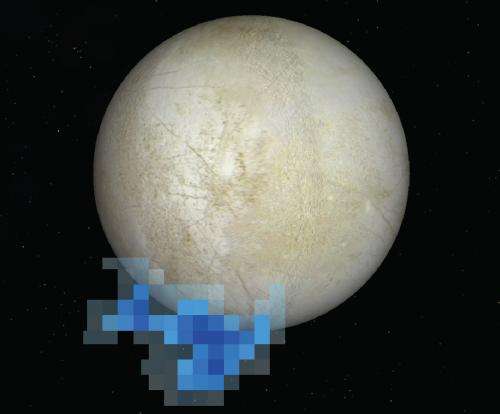NASA’s Galileo shuttle has found evidence of water plumes on Jupiter’s Moon Europa, transporting material from the internal ocean out into space. This not only confirms that Europa has liquid water beneath its frozen surface, but opens up the possibility of sampling Europa’s water without needing to get down to the surface.

When people first considered the possibility of extraterrestrial life, the Moon or Venus seemed likely candidates. Then, as we understood that isn’t really the case, Mars became the main point of interest. But once again, rovers showed that life isn’t really thriving on Mars — though that might have been the case at some point in the past. Now, unlikely candidates have emerged: frigid satellites like Europa.
Researchers believe that beneath its frozen surface, Europa features an ocean of liquid water which may very well host life.
Europa is archetypical of the outer Solar System’s ‘ocean worlds’ — frozen satellites with liquid water hidden beneath a few kilometers of ice. Naturally, an ocean of warm, liquid water sounds like a great place for life to emerge and develop — but how do you study that? The most straightforward way would be to send a lander to places like Europa, drill through the ice, and take samples, but that’s problematic for numerous reasons.
First, it would be extremely costly and pose several technical difficulties. Not only do you need to somehow land on the rough and unforgiving ice, but you also need to drill several kilometers deep. Then, there’s also the risk of contamination, the problem of analyzing the results, and about a million things that could go wrong in the process. But there’s another way which might offer similar results: instead of digging down to the liquid water, what if the liquid water comes to us?
Telescope observations have indicated the existence of water plumes — columns of liquid water flowing to the surface, and even way above it. In 2012 and 2016, Hubble Space Telescope observed plume-like phenomena, but it’s still unclear if what Hubble saw was actually a plume, since the observation was made very close to the telescope’s maximum resolution.
Now, however, NASA has found much clearer evidence of these plumes, thanks to the Galileo spacecraft.
Galileo studied the planet Jupiter and its moons from 1989 to 2004. Looking through the data of a Europa flyby, Xianzhe Jia and colleagues spotted something unusual. During this flyby, which dropped below 400 km altitude, the shuttle’s magnetic instruments detected some unusual magnetic waves and plasma — which they interpreted as a plume.
Reconstructing Galileo’s path, they found that the magnetic anomaly coincides with a region of anomalous temperatures. This unusually hot area can only be fully explained by a transport of heat from Europa’s interior — something was carrying heat from Europa’s depths to the surface. In other words, all the evidence points towards a plume.
This finding could be extremely helpful for future missions to Europa, such as NASA’s Europa Clipper and ESA’s Jupiter Icy Moons Explorer spacecraft, which are scheduled to arrive in Jupiter’s system in the 2020s and 2030s respectively. Being able to study surface water or even better, plumes high up in the atmosphere would make a big difference for these missions.
It’s also not just Europa — Saturn’s moons Enceladus and Titan are also top priorities for extraterrestrial life in our solar system, and they’re also frozen moons with a subsurface ocean of liquid water. We certainly live in exciting times.
Journal Reference: “Xianzhe Jia et al. Evidence of a plume on Europa from Galileo magnetic and plasma wave signatures,” Nature Astronomy. DOI 10.1038/s41550-018-0450-z.


